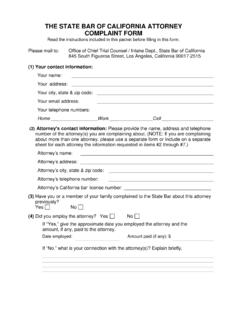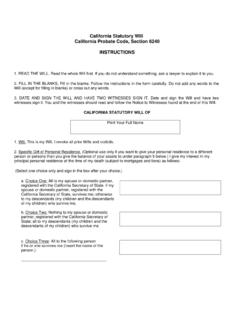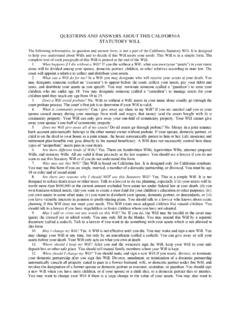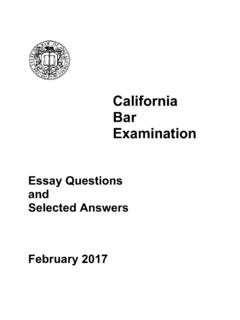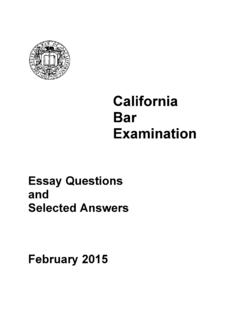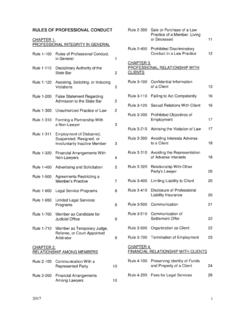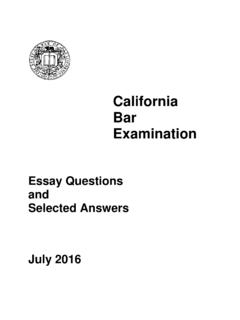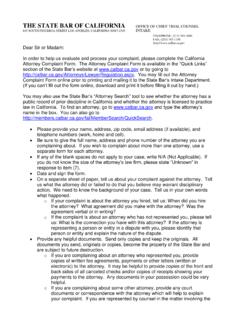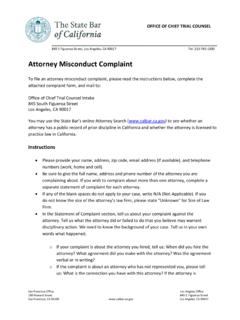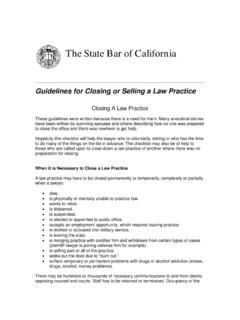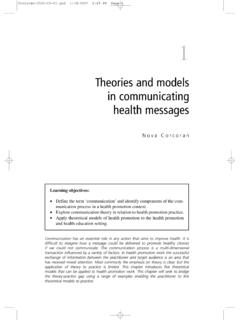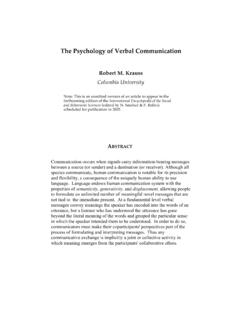Transcription of Rule 4.2 Communication with a Represented Person* (Rule ...
1 Rule Communication with a Represented Person*. (Rule Approved by the supreme court , effective november 1, 2018). (a) In representing a client, a lawyer shall not communicate directly or indirectly about the subject of the representation with a person* the lawyer knows* to be Represented by another lawyer in the matter, unless the lawyer has the consent of the other lawyer. (b) In the case of a Represented corporation, partnership, association, or other private or governmental organization, this rule prohibits communications with : (1) A current officer, director, partner,*or managing agent of the organization;. or (2) A current employee, member, agent, or other constituent of the organization, if the subject of the Communication is any act or omission of such person* in connection with the matter which may be binding upon or imputed to the organization for purposes of civil or criminal liability.
2 (c) This rule shall not prohibit: (1) communications with a public official, board, committee, or body; or (2) communications otherwise authorized by law or a court order. (d) For purposes of this rule: (1) Managing agent means an employee, member, agent, or other constituent of an organization with substantial* discretionary authority over decisions that determine organizational policy. (2) Public official means a public officer of the United States government, or of a state, county, city, town, political subdivision, or other governmental organization, with the comparable decision-making authority and responsibilities as the organizational constituents described in paragraph (b)(1). Comment [1] This rule applies even though the Represented person* initiates or consents to the Communication .
3 A lawyer must immediately terminate Communication with a person* if, after commencing Communication , the lawyer learns that the person* is one with whom Communication is not permitted by this rule. [2] Subject of the representation, matter, and person are not limited to a litigation context. This rule applies to communications with any person,* whether or not a party to a formal adjudicative proceeding, contract, or negotiation, who is Represented by counsel concerning the matter to which the Communication relates. 1. [3] The prohibition against communicating indirectly with a person* Represented by counsel in paragraph (a) is intended to address situations where a lawyer seeks to communicate with a Represented person* through an intermediary such as an agent, investigator or the lawyer's client.
4 This rule, however, does not prevent Represented persons* from communicating directly with one another with respect to the subject of the representation, nor does it prohibit a lawyer from advising a client concerning such a Communication . A lawyer may also advise a client not to accept or engage in such communications. The rule also does not prohibit a lawyer who is a party to a legal matter from communicating on his or her own behalf with a Represented person* in that matter. [4] This rule does not prohibit communications with a Represented person*. concerning matters outside the representation. Similarly, a lawyer who knows* that a person* is being provided with limited scope representation is not prohibited from communicating with that person* with respect to matters that are outside the scope of the limited representation.
5 (See, , Cal. Rules of court , rules , [Limited Scope Representation].). [5] This rule does not prohibit communications initiated by a Represented person*. seeking advice or representation from an independent lawyer of the person's* choice. [6] If a current constituent of the organization is Represented in the matter by his or her own counsel, the consent by that counsel to a Communication is sufficient for purposes of this rule. [7] This rule applies to all forms of governmental and private organizations, such as cities, counties, corporations, partnerships, limited liability companies, and unincorporated associations. When a lawyer communicates on behalf of a client with a governmental organization, or certain employees, members, agents, or other constituents of a governmental organization, however, special considerations exist as a result of the right to petition conferred by the First Amendment of the United States Constitution and article I, section 3 of the California Constitution.
6 Paragraph (c)(1). recognizes these special considerations by generally exempting from application of this rule communications with public boards, committees, and bodies, and with public officials as defined in paragraph (d)(2) of this rule. Communications with a governmental organization constituent who is not a public official, however, will remain subject to this rule when the lawyer knows* the governmental organization is Represented in the matter and the Communication with that constituent falls within paragraph (b)(2). [8] Paragraph (c)(2) recognizes that statutory schemes, case law, and court orders may authorize communications between a lawyer and a person* that would otherwise be subject to this rule.
7 Examples of such statutory schemes include those protecting the right of employees to organize and engage in collective bargaining, employee health and safety, and equal employment opportunity. The law also recognizes that prosecutors and other government lawyers are authorized to contact Represented persons,* either directly or through investigative agents and informants, in the context of 2. investigative activities, as limited by relevant federal and state constitutions, statutes, rules, and case law. (See, , United States v. Carona (9th Cir. 2011) 630 917;. United States v. Talao (9th Cir. 2000) 222 1133.) The rule is not intended to preclude communications with Represented persons* in the course of such legitimate investigative activities as authorized by law.
8 This rule also is not intended to preclude communications with Represented persons* in the course of legitimate investigative activities engaged in, directly or indirectly, by lawyers representing persons* whom the government has accused of or is investigating for crimes, to the extent those investigative activities are authorized by law. [9] A lawyer who communicates with a Represented person* pursuant to paragraph (c) is subject to other restrictions in communicating with the person.* (See, Bus. &. Prof. Code, 6106; Snider v. Superior court (2003) 113 1187, 1213 [7. 119]; In the Matter of Dale (2005) 4 Cal. State Bar Ct. Rptr. 798.). 3. NEW RULE OF PROFESSIONAL CONDUCT (Former Rule 2-100). Communication with a Represented Person EXECUTIVE SUMMARY.
9 The Commission for the Revision of the Rules of Professional Conduct ( Commission ). evaluated current rule 2-100 ( Communication with a Represented Party) in accordance with the Commission Charter. In addition, the Commission considered the national standard of ABA Model Rule (concerning communications with a Represented person) and the Restatement of Law Governing Lawyers counterpart, Restatement 99 ( Represented Nonclient The General Anti-Contact Rule). The result of the Commission's evaluation is proposed rule ( Communication with a Represented Person). Rule As Issued For 90-day Public Comment Proposed rule carries forward the substance of current rule 2-100, the no contact rule, and prohibits a lawyer who represents a client in a matter from communicating, either directly or indirectly, about the subject matter of the representation with a person Represented by a lawyer in the same matter.
10 The rule is intended to protect the Represented person against (i) possible overreaching by the prohibited lawyer, (ii) interference by the prohibited lawyer with the client-lawyer relationship, and (iii) the uncounseled disclosure of privileged or other confidential information. In addition to containing the basic prohibition in paragraph (a), the proposed rule would carry forward, largely intact, the other black letter provisions in current rule 2-100(B) and (C). as paragraphs (b) and (c). As originally circulated for 90-day public comment, there were also two new paragraphs: paragraph (d), which would have imposed a duty on a lawyer to treat with fairness a Represented person with whom communications are permitted under the rule ( a public official), (see Revisions Following 90-Day Public Comment Period, below), and paragraph (e), which included two definitions intended to avoid ambiguity in the application o f the rule (now re-lettered paragraph (d).)
